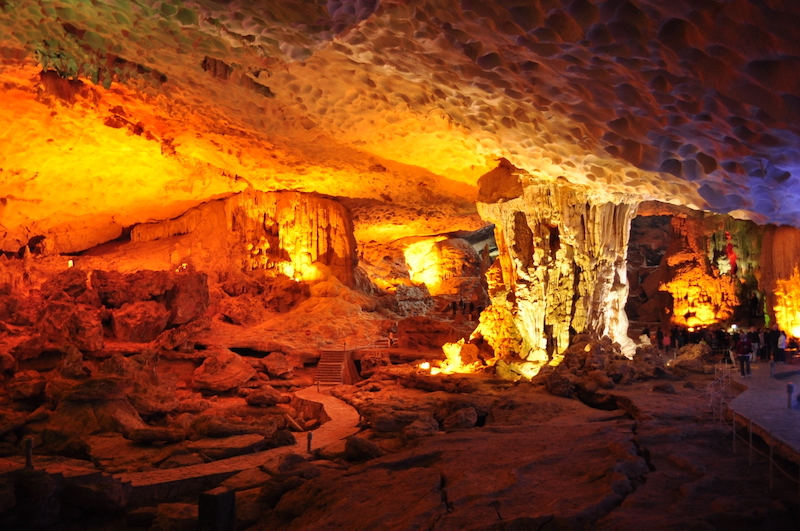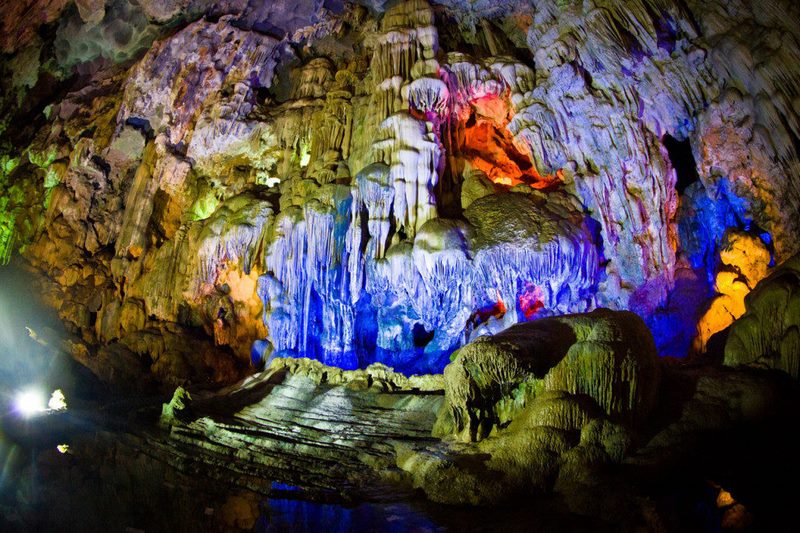Vietnam’s Ha Long Bay is among karst limestone terrain areas in the world that have been recognized by UNESCO as World Natural Heritage. Karst caves and grottoes, or hollow spaces of different shapes and sizes inside limestone blocks, are formed by limestone being eroded by rainwater and at different levels; therefore, life in caves appears to be diverse.

Sung Sot Cave
Caves in Ha Long Bay are scientifically divided into three main groups: ancient caves (those with considerable height - Sung Sot cave, Tam Cung cave, Lau Dai cave, Thien Cung cave and Dau Go cave), base caves (not really high compared to sea level - Trinh Nu cave, Bo Nau cave, Ho Dong Tien cave), and frog jaw caves (formed by the process of dissolving and eroding of sea water - Ho Ba Ham cave, Luon cave)
Unlike the outside environment, the living environment inside Ha Long Bay’s caves seems quite stable, or literally speaking, like a world of darkness with little change in temperature and high humidity. The lack of light makes these caves become mainly inhabited by animals and few plants can grow there. Not only do those animals have to adapt to harsh conditions but they also succeed in surviving in an environment with scarce food.
All living things, basically, depend on sunlight, even those inhabiting the darkest caves. Leaves and rotten branches are carried down the drains by rainwater, and bat droppings are a source of food for fungi and bacteria. Insects eat fungi and bacteria and they become food for larger animals, then their excrement becomes food for fungi and bacteria, becoming a continuous food chain in caves. Though animals in those caves prefer the dark, they can still live outside when necessary to find food. Typical examples include earthworms, dung beetles, cave crickets, frogs, salamanders and some crustaceans.

Thien Cung Cave
Cave crickets are wingless and have a typical humpback. They have very long pincers and are capable of great jumping heights as a compensation for their lack of wings. Cave crickets have very long antennae. They usually live in dark, damp places, Ho Dong Tien Cave for instance. Cave crickets feed on decaying organic matter in caves.
One of the most common cave dwellers is milky white and eyeless cave bugs found in abundance in caves.
A research program on invertebrates in Ha Long Bay carried out by the Ha Long Bay Management Board and a group of scientists from the Fauna and Flora International (FFI) in 2003 discovered a type of freshwater fish in Duc Tien cave (Van Gio island). This new species of fish belongs to the loach genus, with the scientific name Draconectes narinosus. The fish have no eyes and no scales, which helps them adapt to living in the dark and deep in limestone caves. This confirmed the assumption that animals are able to live inside the caves filled with freshwater on the rocky islands emerging in the middle of the sea. Professor Boris Sket, a member of the survey team, said that this could be a freshwater fish species that existed when Ha Long Bay was still a continent.
Most of the cave dwellers found in Ha Long Bay are white or pinkish in color. They have little dark pigmentation because they do not need protection from the sun or camouflage to hide from predators. Many species have no eyes or have degenerate, underdeveloped eyes. However, they often have long legs and antennae which enable them to be adaptive in darkness with a small amount of food.
The number of creatures in the cave seems quite small and their lives are very fragile compared to their relatives outside these caves; therefore, the conservation programs need to be given thorough consideration so as not to produce negative effects on their survival.
By Tran Minh
















